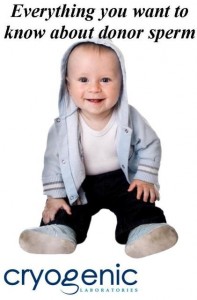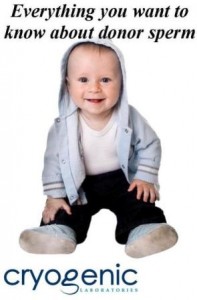Blog written by Joseph D. Schulman, M.D. Founder, Genetics & IVF Institute
Choosing a sperm donor is a very important decision, and everyone brings their own perspectives to this challenge. With many years of experience caring for patients with problems in reproduction and medical genetics, I hope to help you reach the final donor decision that is right for you. I will also explain why only a small minority of men are able to meet the difficult requirements for being sperm donors at CLI.
It is essential to maximize safety from the risks of inadvertent transmission of an infectious disease. Only frozen donor sperm should be used, and then only if the sperm samples have been quarantined and the donor fully retested several months after the sperm was obtained to exclude infectious diseases. Using fresh sperm always carries some risk that the donor may have been exposed to HIV or other diseases so recently that it would not produce abnormalities on concurrent laboratory testing. From the inception of its donor sperm program in the 1980s, CLI has consistently provided only frozen, quarantined donor sperm which is cleared for sale only after the donor has had extensive initial infectious disease testing followed by retesting after a long quarantine period. You can have complete confidence that every dose of frozen sperm sold by CLI and its affiliates meets this rigorous safety standard.
Another important safety consideration is minimizing the risk of transmission of a genetic disease to the child. We have pioneered for many years in genetic disease prevention. Our Cryobank is the only major bank which has full-time medical geneticists and genetic counselors on its staff to carefully screen potential donors for any family history or clinical manifestations of genetic illnesses. Furthermore, all donor candidates undergo the most extensive battery of genetic tests of any sperm bank, and all results are reviewed by our own genetics professionals. While the risk of genetic disease transmission can never be completely excluded, you can be confident that acquiring sperm from CLI guarantees that this serious donor risk factor is reduced to the lowest level available anywhere.
There is much misunderstanding about the importance of inheritance in determining the kind of child which will result from the contribution of its biological father. Each egg and sperm contains half the genes of the respective parent, and thus the child shares half its genes with each parent – but only half. There is no way to determine which genetic attributes will be inherited by a specific individual until after conception, when in special cases genetic testing on the embryo, fetus, or child can provide useful information. Thus children to some extent resemble their parents, but the resemblance is far from complete. The genetic connection to siblings also involves sharing half of one’s genes. Siblings typically are far from identical in most characteristics – but they nevertheless tend to resemble one another more than would two randomly selected, unrelated people.
How much does genetic inheritance really matter in determining what kind of person one becomes? Optimizing the environment, broadly defined to include good nutrition, parental love, excellent educational opportunities, and more will of course help each child reach its full potential. But there is extensive evidence that this potential is heavily influenced by inheritance. The best proof comes from long-term studies of identical twins – who are genetically identical – but who have been separated near the time of birth and thereafter reared apart. A definitive summary of research on identical twins reared apart has recently been compiled by Nancy L. Segal, Ph.D., in her book “Born Together – Reared Apart: The Landmark Minnesota Twin Study”. The fundamental conclusion from decades of research is that the life patterns, accomplishments, intelligence, and appearance of identical twin pairs, who in many cases never met again until very advanced ages, are amazingly similar. So genetics matters a great deal in determining who we are and what we will become in childhood and adult life. Most scientists now recognize that intelligence is at least 50% determined by inheritance, and many would place that number closer to 70%. Such traits as musical ability, artistic talent, athletic aptitude, and many more are also partly genetic.
For this reason, we recommend that even allowing for the variability in inheritance of specific genes from biological parents, significant thought be given to choosing a sperm donor who has the qualities that one might like to see in one’s child. There is no guarantee that a specific quality will indeed be expressed in the child, but there is a greater likelihood of it occurring than if this is not factored into the decision about which donor to use. This is why our Cryobank donor pool is very carefully selected not only to exclude detectable propensities to adverse traits but very importantly to include positive attributes widely desired by many parents. We exclude donors with histories or evidence of alcohol or drug abuse, negative behavioral characteristics, manic depressive illness or schizophrenia, and potentially heritable physical limitations. We utilize donors who are college students or who may have advanced degrees (including doctoral degrees) providing evidence of substantial intelligence. Detailed information about the talents, interests, attributes, and appearance of our donors is available, and specific additional information is available to you upon request. Our goal is to ensure that you are able to choose from an exceptionally large number of sperm donors who are high quality people.
Lastly, it is important to note that the large majority of donor candidates who meet all the above standards for infectious and genetic safety and who have admirable characteristics are nevertheless rejected as donors at CLI. It is an unexplained biological fact that the sperm of most men does not freeze well. Thus while fresh sperm from most men easily initiates pregnancies, only a small minority produce sperm which can be frozen, stored, and thawed before use and still retain the exceptional viability and vitality needed to produce pregnancies at a high rate.
In the final analysis, when you choose sperm from one of our donors you are selecting among potential biological fathers who have been very, very carefully interviewed, screened, and tested to meet all the necessary requirements for being an outstanding sperm donor. Less than 1% of all donor applicants are successfully accepted as donors at CLI. We have found these donors through considerable effort based on an understanding of the strong importance of the various issues discussed in this article. We wish you good luck in your choice of the best donor for you.
 We are here to help, and if any additional information on any of our donors is important to you we shall do our utmost to provide it. Just call 800-466-2796. We are confident you will find what you need at Cryogenic Laboratories, Inc.
We are here to help, and if any additional information on any of our donors is important to you we shall do our utmost to provide it. Just call 800-466-2796. We are confident you will find what you need at Cryogenic Laboratories, Inc.
 Stay tuned: The next blog will include information about placing your donor sperm order.
Stay tuned: The next blog will include information about placing your donor sperm order.



